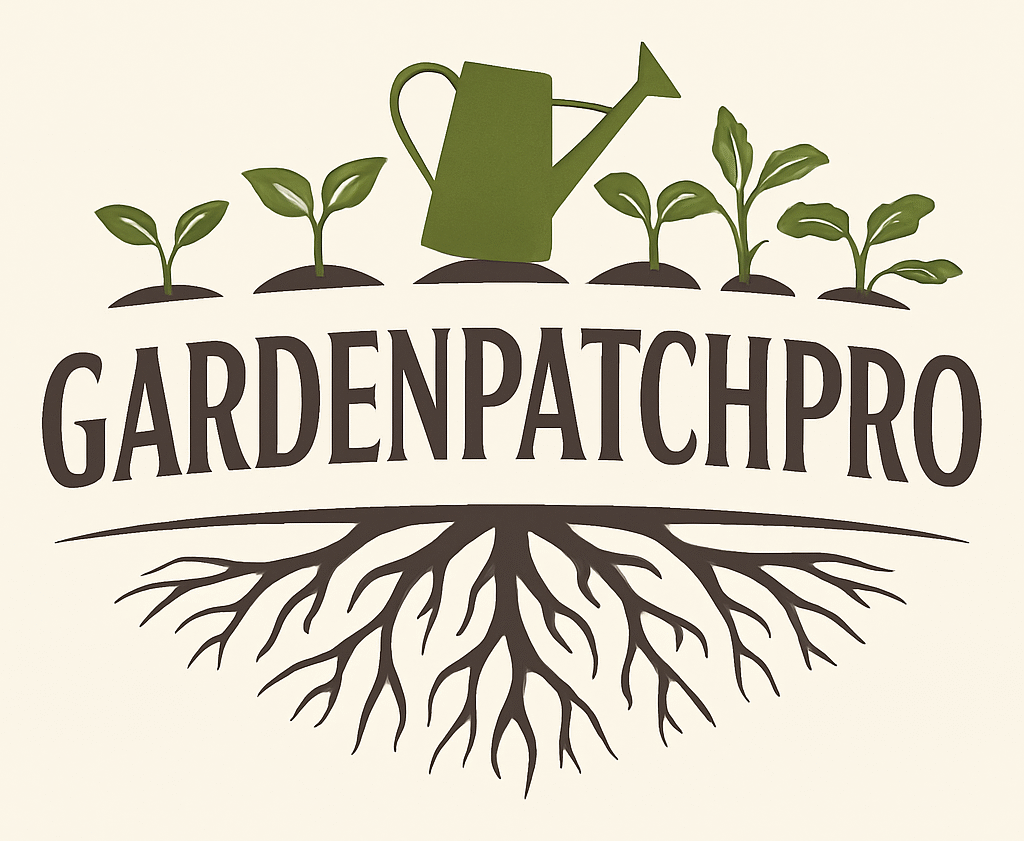16 Garden Nook Ideas to Transform Your Outdoor Space Efficiently
A garden nook is a small, inviting space in an outdoor area designed for relaxation and quiet moments. It can fit in any size yard or garden, offering a personal spot to enjoy nature or unwind.

These 16 garden nook ideas help create comfortable, peaceful places that enhance any outdoor space. They show how simple design changes can turn a regular garden into a calming retreat.
1) Vine-covered arch seating area

A vine-covered arch creates a natural and charming entrance to a garden nook. It adds both beauty and a sense of privacy by framing the seating area with greenery.
The arch can be made from wood, metal, or other sturdy materials. Climbing plants like ivy, wisteria, or jasmine work well to cover the structure and provide shade.
Underneath the arch, a small bench or a set of cushioned chairs offers a cozy place to sit. Soft lighting, like lanterns or fairy lights, can brighten the space in the evening.
This setup blends nature and comfort. It invites quiet moments for reading, relaxing, or enjoying a cup of coffee surrounded by plants.
For ideas on how to design a vine-covered arch seating area, one can explore garden arbor ideas with vines or check inspiration from charming garden nook ideas.
2) Rustic wooden garden bench

A rustic wooden garden bench adds a natural, simple charm to any garden nook. It blends well with plants and outdoor spaces, creating a peaceful spot to sit and relax.
The bench often uses weathered or reclaimed wood. This gives it a worn, authentic look without needing much upkeep. Adding soft cushions can increase comfort and invite longer stays.
Placing the bench under a tree or near flowers, like hydrangeas, can enhance its beauty. It becomes a cozy focal point where people can enjoy nature quietly.
Building a rustic bench is usually easy. Many use materials found around the house, making it an affordable choice. Creativity in design helps the bench fit perfectly into the garden’s style.
For ideas on combining style and comfort with rustic wooden benches, one can explore garden bench ideas or check examples of rustic garden bench designs to find the best fit for their outdoor space.
3) Hanging wicker chair nook
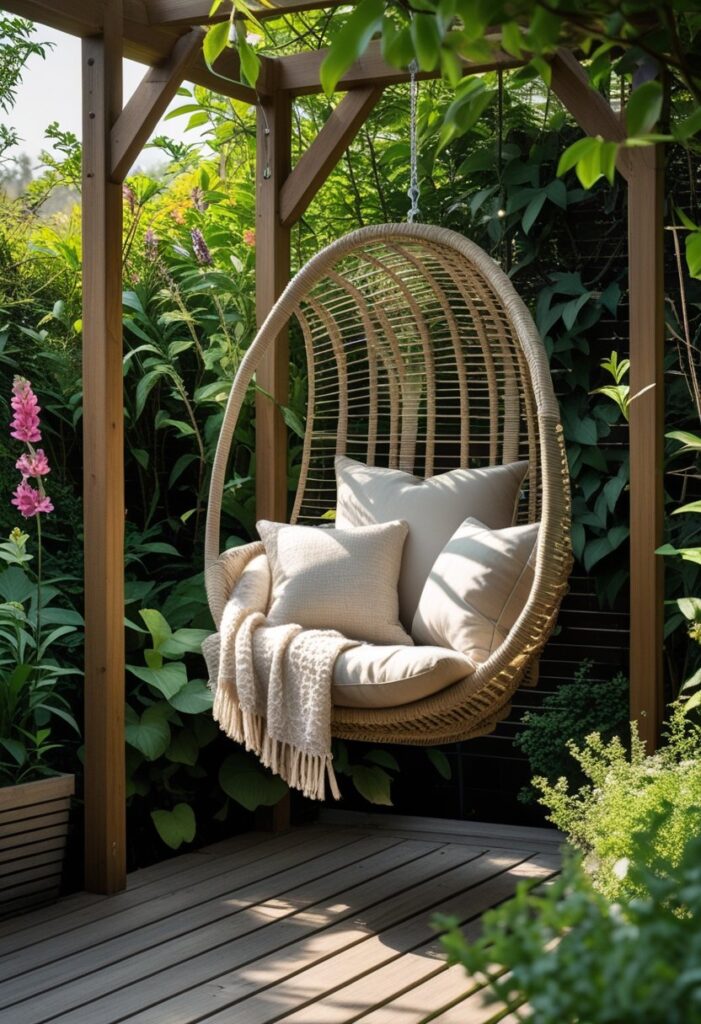
A hanging wicker chair adds style and comfort to a garden nook. It provides a cozy spot to sit and relax, perfect for reading or enjoying nature. The natural woven texture fits well with outdoor settings.
To keep the chair safe and stable, it should hang from a strong metal frame or sturdy tree branch. This avoids damage to the tree and makes the chair secure.
Adding cushions in soft or neutral colors makes the nook even more inviting. A canopy or nearby plants can offer shade and filter sunlight, creating a calm atmosphere.
This type of seating works well in small spaces. It adds charm without taking up too much ground space. A hanging wicker chair can become the favorite spot in any garden nook.
More ideas to create a unique hanging wicker chair nook are available at 16 Beautiful Garden Nook Seating Ideas.
4) Built-in stone seating with cushions
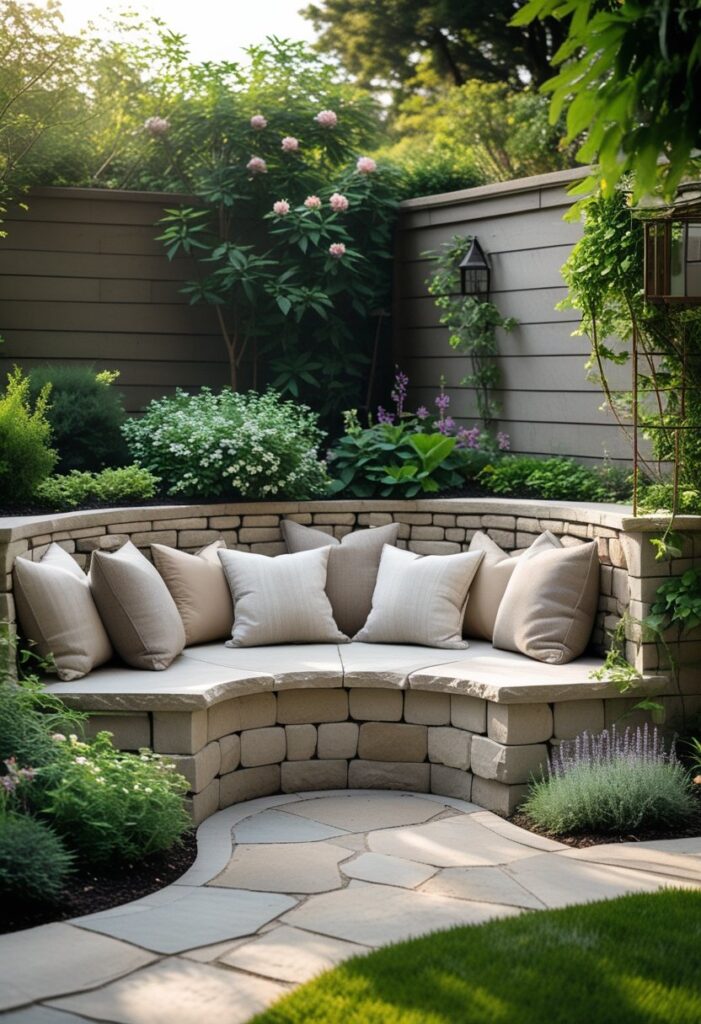
Built-in stone seating adds a natural, sturdy feature to any garden nook. It blends well with outdoor surroundings while providing lasting durability against weather. Stone benches can be arranged in curves or straight lines to fit different spaces.
Adding cushions improves comfort and invites longer stays. Weatherproof cushions are ideal because they resist moisture and fading. Using soft, neutral colors keeps the look calm and natural.
This seating option works well near pathways or under trees. It creates a quiet spot for reading or small gatherings. A few bright cushions can also add a touch of color without disrupting the garden’s harmony.
Stone seating fits many garden styles, from modern to rustic. It requires minimal maintenance but rewards with both style and function. For ideas on similar stone bench setups, see outdoor stone bench ideas.
5) Secluded pergola retreat
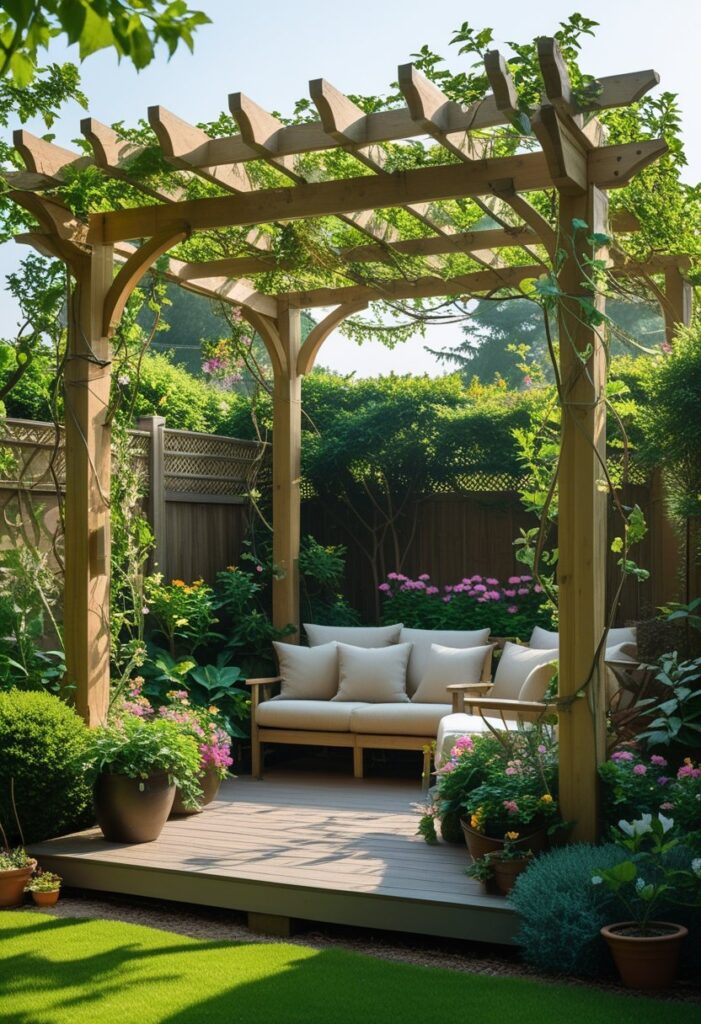
A secluded pergola retreat offers a quiet and private spot in the garden. It can be covered with climbing plants like vines or roses to create natural shade and add beauty. The cover also helps make the space feel more enclosed and peaceful.
Inside the pergola, comfortable seating like cushioned benches or chairs can be placed. Adding soft lighting such as string lights or lanterns makes the area usable in the evening. It provides a calm place for reading or having quiet conversations.
This garden nook suits both small and large spaces. Even a compact corner can be transformed by building a simple pergola frame. Creating this kind of retreat brings structure and calm to the outdoor area.
For more ideas on how to design and decorate a pergola retreat, explore 16 Inspiring Garden Nook Ideas for a Relaxing Retreat.
6) Small corner with potted plants
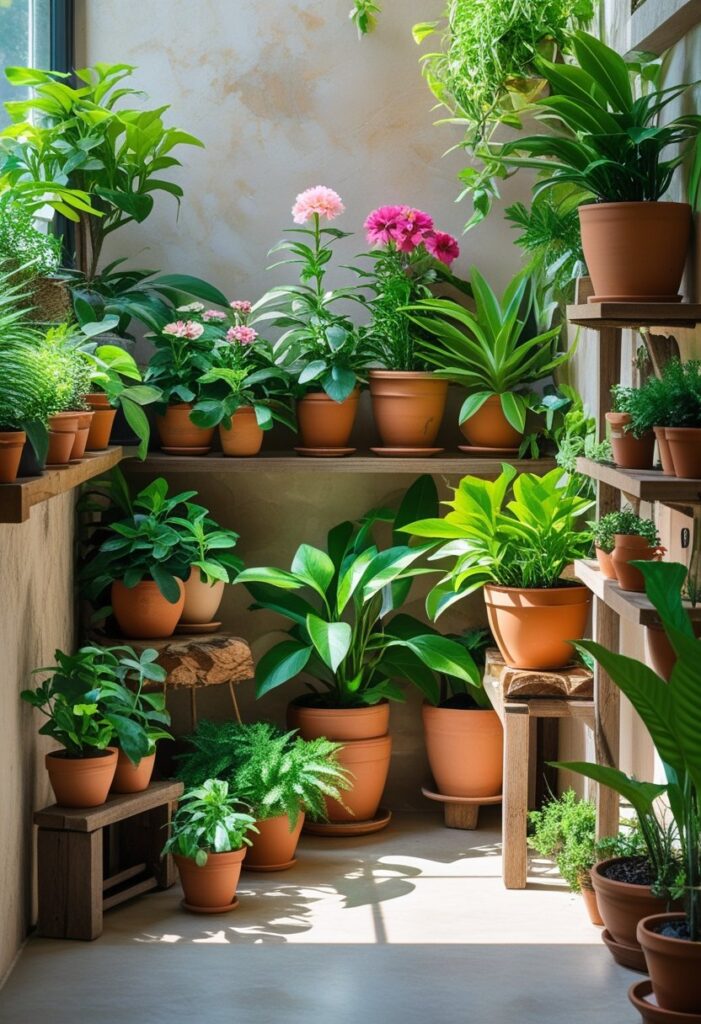
A small corner with potted plants can turn an unused space into a lively garden nook. Using pots allows for easy arrangement and flexibility. Different sizes and shapes of pots create visual interest without taking up much floor space.
Vertical stands help add layers and depth. They also save room by stacking plants upward instead of spreading out. Mixing herbs, flowers, and leafy plants gives a varied look. This combination adds color, texture, and fragrance.
Adding a small chair or bistro set makes the nook functional for relaxing or reading. A tiny table can hold a drink or book, enhancing comfort. This simple setup works well on patios, balconies, or small yards.
For easy changes, potted plants can be moved or replaced seasonally. Creating a green corner like this is a practical way to enjoy nature in tight spaces. More details on styling a small garden corner with pots can be found at 18 Dreamy Backyard Garden Nook Ideas for a Relaxing Haven.
7) Cozy hammock between trees
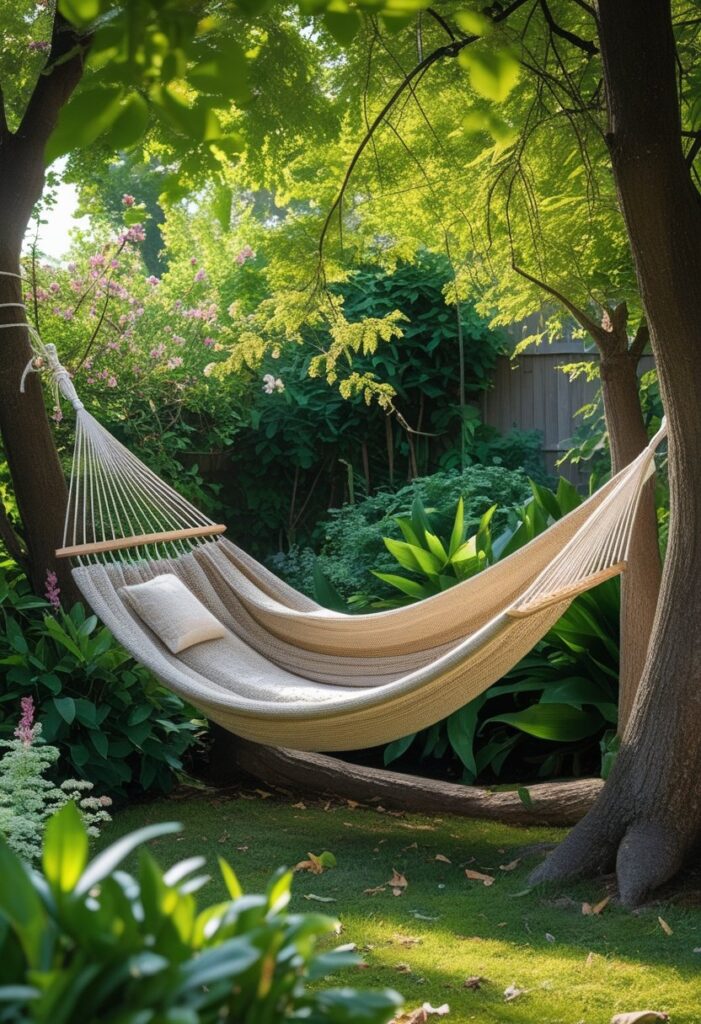
A hammock hung between two sturdy trees creates a simple and relaxing garden nook. It offers a quiet place to rest, read, or enjoy nature. Trees provide natural shade, making the spot cool and comfortable during warm days.
Choosing trees about 12 to 15 feet apart works well for most hammocks. The hammock should be tied securely to ensure safety and stability. Adding soft cushions or blankets can increase comfort.
Surrounding the hammock area with flowers or tall grasses adds privacy. Soft lighting, like lanterns, makes it inviting in the evenings. This setup blends well into the garden without needing much extra space.
For more ideas on hammock garden setups, see 16 National Hammock Day Relaxing Garden Nook Ideas.
8) Fire pit with surrounding chairs
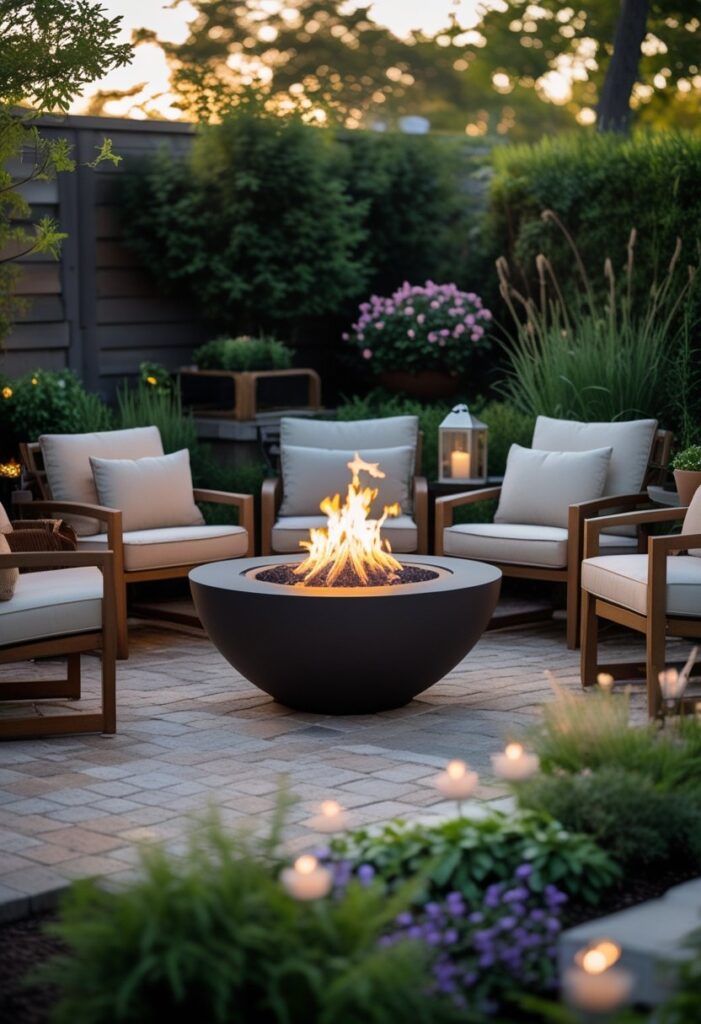
A fire pit with chairs around it creates a simple and inviting garden nook. It offers a warm spot for relaxing or socializing outdoors. People often choose comfortable chairs like Adirondack styles for added support.
Using movable chairs allows flexibility in seating arrangements. They can be repositioned for different group sizes or to follow the sun. Some prefer built-in stone benches for a more permanent, polished look.
Adding soft textures, like blankets or cushions, makes the area cozier. Surrounding the fire pit with low-maintenance plants helps define the space without much upkeep. Gravel or sand bases keep the area tidy and safe.
This setup fits well in many garden styles, from modern to rustic. It invites quiet moments by the fire or casual gatherings with friends. More ideas about creating fire pit seating spaces can be found in this collection of backyard fire pit seating ideas.
9) Bamboo screen privacy area
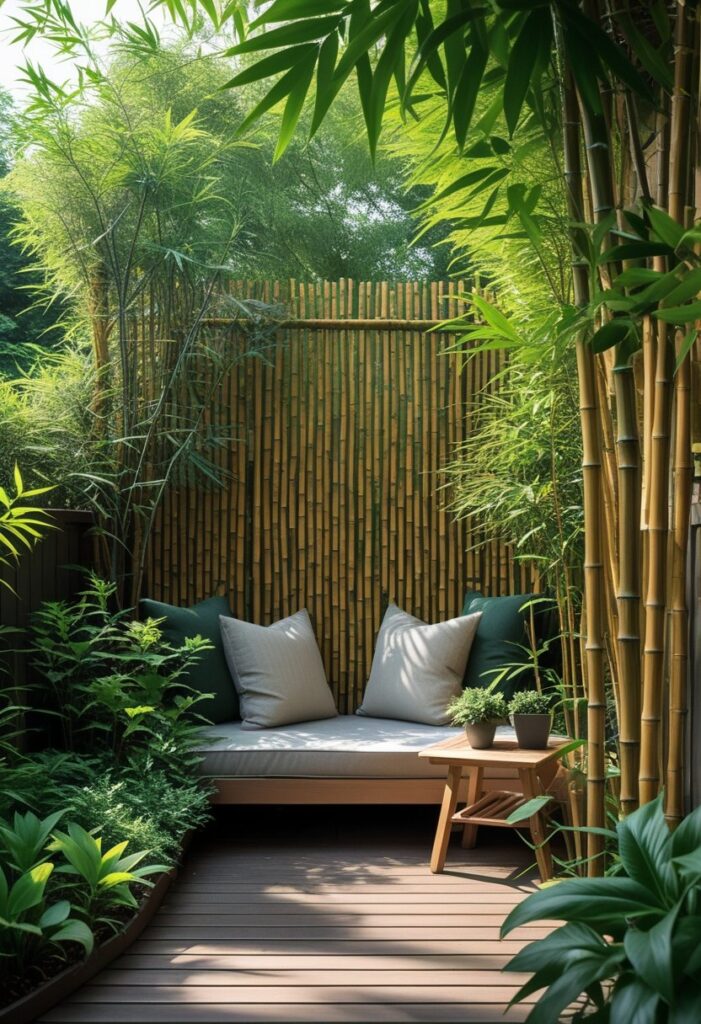
Bamboo is a fast-growing plant that works well to create a natural privacy screen. It grows tall and dense, blocking unwanted views efficiently.
The structure of bamboo makes it rigid and stable. This helps form a clear wall of greenery that adds depth and calm to any garden nook.
Because bamboo grows quickly, it is ideal for those who want privacy without waiting years. It also fits well in different garden styles, bringing a fresh, green look.
Bamboo screens soften harsh lines from fences or walls. They can turn a plain corner or fence line into a peaceful, private retreat.
Using bamboo for privacy is practical and attractive. It creates a natural barrier that feels open, not closed off or prison-like. For creative ideas and tips, see more on bamboo privacy ideas and backyard bamboo privacy.
10) Floating deck with lounge chairs

A floating deck with lounge chairs creates a simple, relaxing spot in a garden nook. The deck sits slightly above the ground, making the area feel open and inviting. It works well for sunbathing or reading outdoors.
Lounge chairs add comfort and encourage longer stays outside. They can be arranged to face a view, a fire pit, or each other for easy conversation. Choosing weather-resistant materials ensures the furniture lasts through different seasons.
The floating deck design allows it to be placed nearly anywhere in the yard, under a tree or in a sunny patch. This flexibility helps create a quiet retreat suited to the space available.
Adding cushions or small side tables can improve usability without cluttering the area. This setup keeps the nook functional and easy to maintain.
More ideas for floating decks can be found at 21 Floating Deck Ideas – ThatWoWHome for inspiration on layout and design.
11) Repurposed vintage window seating
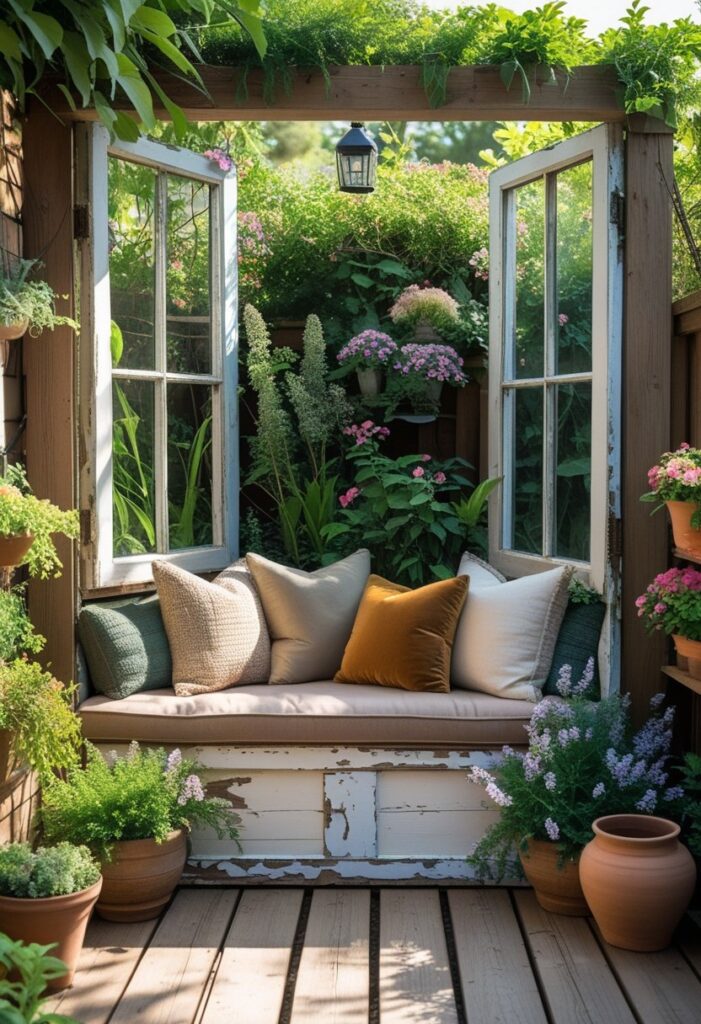
Repurposed vintage windows can create a unique garden nook seating area. Using old window frames as a bench back or side panels adds charm and character to the space. This approach brings a touch of history and style to the garden.
They often use cushions and pillows to make the seating comfortable. Adding soft fabrics helps balance the hard texture of wood or metal window frames. It creates a cozy spot that invites relaxation.
Vintage windows also provide an eco-friendly solution. Rather than discarding old windows, repurposing them reduces waste and gives the garden a distinct look. These vintage elements can serve as both functional seating and decorative features.
Using vintage windows helps define the nook with a rustic or classic feel. Paired with natural greenery or climbing plants, they blend well into outdoor spaces. For ideas on how to use windows for seating and garden décor, see vintage window seat ideas and upcycled window garden ideas.
12) Raised flower bed seating ledge
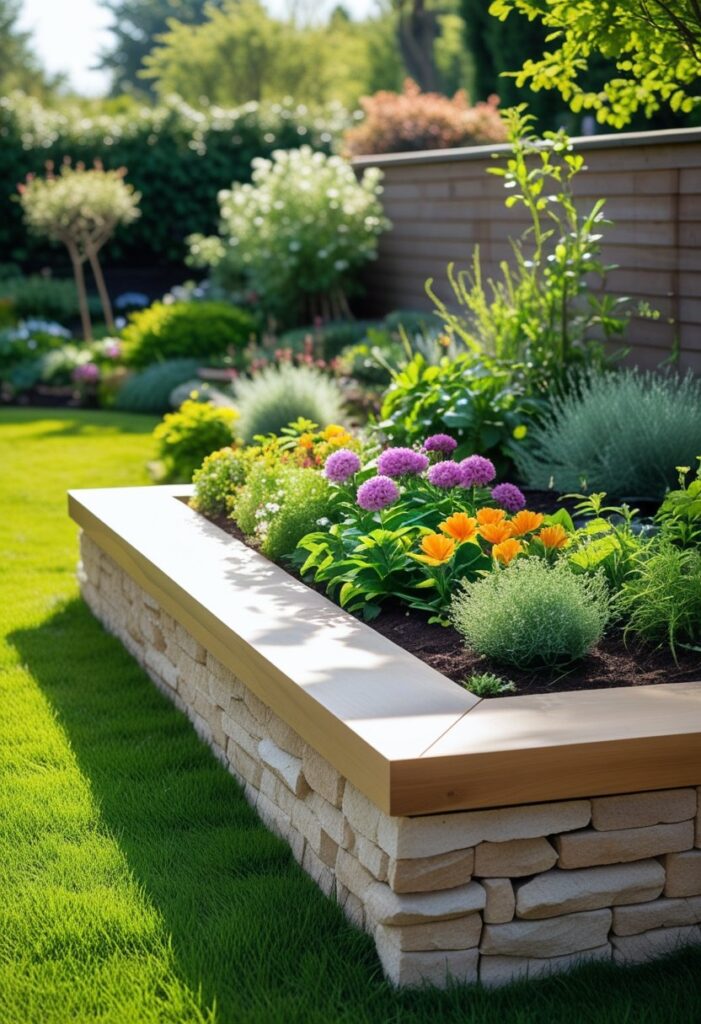
A raised flower bed with a seating ledge offers a practical way to add both planting space and a spot to sit. The ledge, often made from wood or stone, runs along the edge of the bed. It can serve as a bench for relaxing or gardening.
This design helps save space by combining two functions in one structure. It encourages spending more time outdoors surrounded by flowers and plants. The seating height is usually comfortable to sit on without needing extra cushions.
The raised bed provides good soil drainage and makes gardening easier by reducing the need to bend over. Adding a ledge creates a natural resting place close to the plants. It suits small garden nooks or patios where space is limited.
Materials like stone or treated wood are common for the ledge and frame. This ensures durability and blends well with garden styles. For ideas on how to build or style these setups, looking at examples of raised garden beds with seating shows many options.
More ideas about combining raised beds and seating are available from detailed guides on raised flower bed designs with seating ledges.
13) Outdoor daybed with canopy
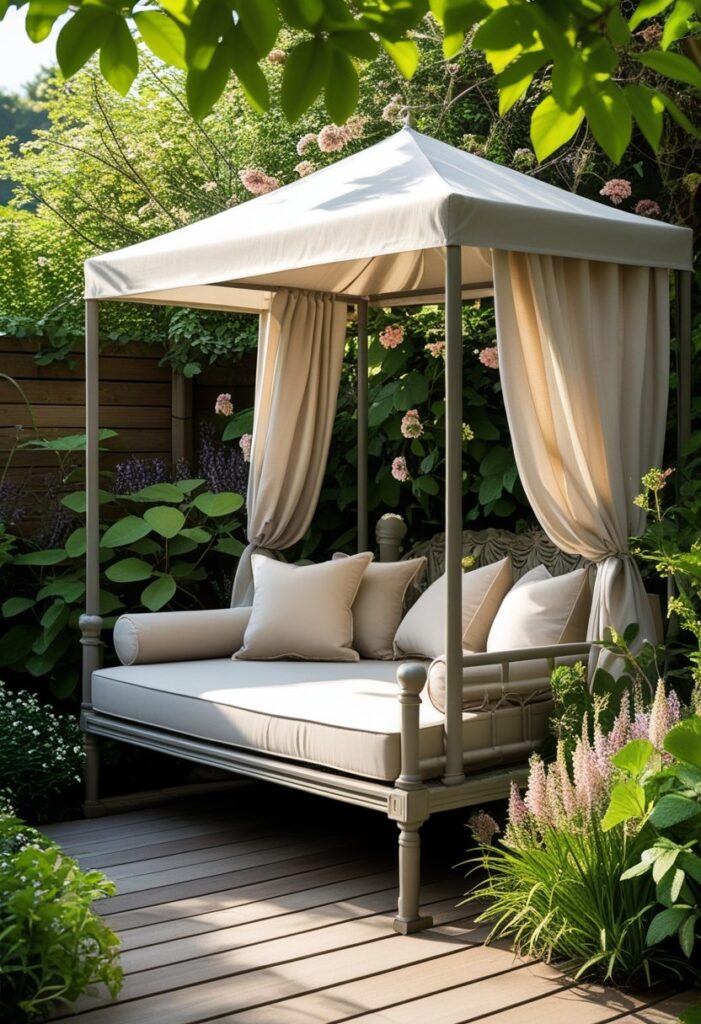
An outdoor daybed with a canopy offers a comfortable place to relax while staying protected from the sun. The canopy helps block harsh sunlight, making it easier to enjoy the outdoors for longer periods.
Daybeds often come with cushions and pillows that have waterproof covers, adding both comfort and durability. These cushions make the daybed soft and inviting, perfect for reading or napping outside.
The canopy can be made from fabric or mesh, which may be draped or attached securely to the frame. This adds a cozy feel and some privacy to the space.
Building a DIY outdoor daybed with a canopy is possible with simple plans and materials. It can be a cost-effective way to create a stylish and functional garden nook tailored to personal taste.
Using a sturdy metal frame or wooden structure ensures the daybed remains stable and safe to use. Adding decorative elements like curtains or trailing plants around the canopy increases the charm of the setup.
For more ideas and guides on creating an outdoor daybed with a canopy, see this DIY outdoor daybed with canopy.
14) Trellis covered with climbing roses

A trellis covered with climbing roses can create a charming focal point in any garden nook. The roses add both color and fragrance, enhancing the space’s appeal. Choosing a sturdy trellis is important to support the weight of the climbing roses over time.
Climbing roses need room to grow and proper care. Using disease-resistant varieties helps ensure they stay healthy and bloom well. The trellis guides the roses upward, creating a natural wall or arch that adds vertical interest.
This setup works well in small or large gardens. It can frame a seating area or create a private corner. For ideas and design inspiration, one can explore climbing roses trellis ideas to find styles that match different garden themes.
A rose-covered trellis also requires regular pruning to keep the plant tidy and strong. This maintains the beauty of the garden nook and prevents the roses from becoming overgrown.
15) Garden swing under a tree
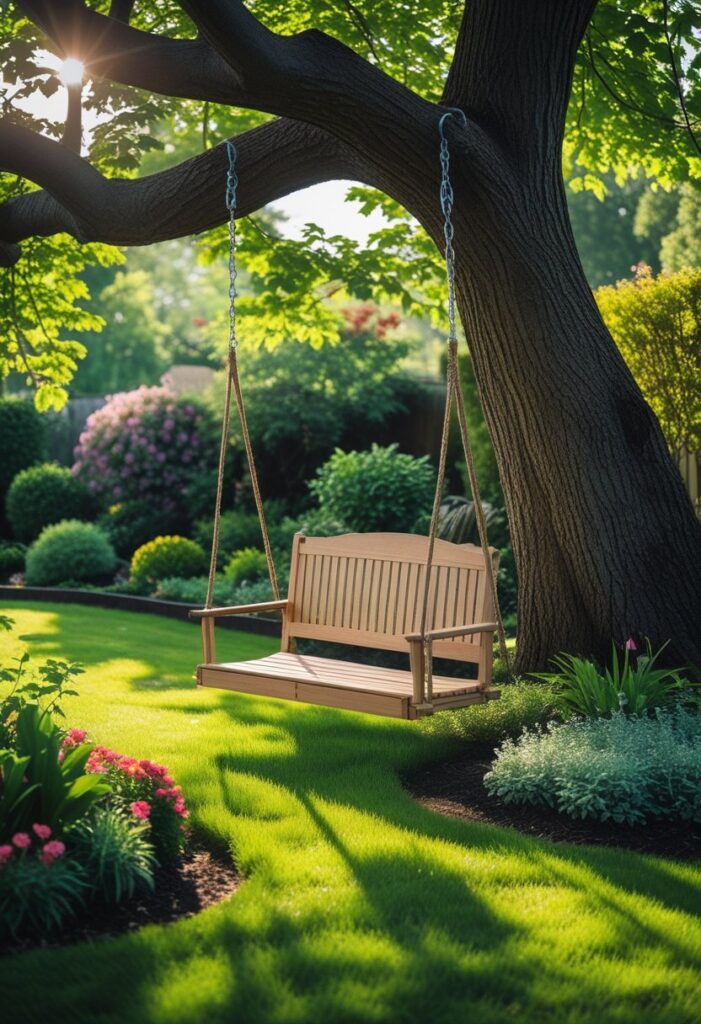
A garden swing under a tree creates a simple, relaxing spot. It offers shade and a gentle breeze, making it comfortable during warmer days. The natural setting adds to the peaceful feeling.
The swing can be hung from a sturdy branch or set up with a frame nearby. Adding cushions or soft pillows makes the seat more inviting. Surrounding the swing with flowers or greenery can enhance its charm.
This setup suits many backyard sizes, from large gardens to compact spaces. It encourages quiet moments, reading, or casual conversation. A garden swing under a tree combines comfort and nature well, making it a smart choice for an outdoor nook.
For more ideas, see garden swings under trees for inspiration.
16) Compact reading nook with bookshelf

A compact reading nook with a bookshelf is perfect for small outdoor spaces. It makes good use of limited room while keeping books close at hand. This setup combines seating and storage efficiently.
The nook can fit into a corner or along a garden wall. Adding a small waterproof bookshelf protects books from weather. It also keeps the area neat and organized.
Comfortable seating is key. A bench or a built-in seat provides a cozy spot to read. Soft cushions help to make the space inviting.
Plants or shade elements can enhance privacy and comfort. A small canopy or climbing vines give shelter without taking up much space.
This idea is practical and simple to build. It creates a quiet retreat without needing a large garden. See more details on creating an outdoor alcove with bookshelf.
Design Principles for a Cozy Garden Nook
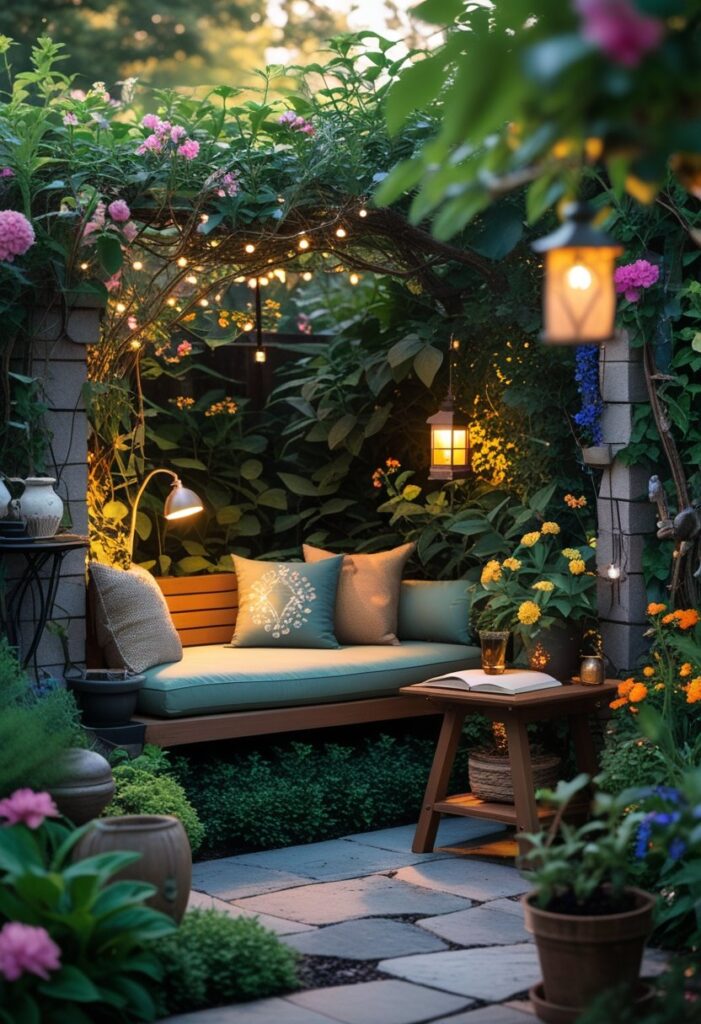
Creating a garden nook that feels inviting and calm depends on thoughtful choices. The right spot, natural elements, and the balance between privacy and openness all shape how welcoming the space will be and how well it fits the outdoor area.
Choosing the Right Location
The location sets the tone for the entire garden nook. It should be a place that naturally draws attention or provides a quiet corner away from busy spots.
Look for areas with good sunlight that match the nook’s intended use. Morning sun is ideal for breakfast nooks, while shaded spots work better for afternoon relaxation. Check that the ground is level or easy to level for comfortable seating.
Consider proximity to the house and pathways. A nook too far away might feel isolated, while one too close might miss the chance for peaceful escape. Good views and gentle breezes increase enjoyment.
Incorporating Natural Elements
Natural features add texture and comfort to the garden nook. Plants, water, and natural materials all help build a space that feels part of the outdoor environment.
Use plants to frame the nook, create shade, or add color. Climbing vines and shrubs can soften hard edges. Water elements like small fountains or birdbaths add calming sounds.
Select materials like wood, stone, or bamboo for seating and decor to give the nook an organic feel. Mix textures such as smooth stones with rough wood for visual interest. Keep the plant choices suitable for local climate and light.
Balancing Privacy and Openness
Privacy makes a garden nook feel cozy, but too much enclosure can feel cramped. Openness invites fresh air and views but may expose the space to distractions.
Use hedges, lattice panels, or tall plants to block unwanted sightlines without fully enclosing the nook. Partial coverings, like pergolas with climbing greenery, allow light and air while providing shelter.
Arranging furniture to face inward or toward a garden feature helps build a sense of enclosure. Maintaining clear paths and sightlines to other parts of the yard preserves a connection to the surroundings. This balance makes the nook both relaxing and inviting.
Enhancing Comfort and Functionality
Creating a garden nook that is both comfortable and practical involves choosing the right seating, lighting, and protection against the weather. These factors work together to make the space inviting and usable throughout different times and seasons.
Seating Options and Materials
Seating is the core of any garden nook. Options include benches, chairs, hammocks, or built-in seating. The choice depends on space and use. For a small nook, a compact bench or foldable chairs save space. Larger areas can fit cushioned loungers or swing seats.
Materials should be durable and easy to maintain. Teak, cedar, and metal resist weather damage. Adding cushions with water-resistant fabric boosts comfort without risking mildew. Mixing seating types, like a bench plus cushions or a hammock, adds versatility for relaxation and entertaining.
Lighting Solutions for Ambiance
Lighting sets the mood and extends the use of the nook after dark. Solar-powered lights are an energy-efficient option that requires no wiring. String lights or fairy lights hung overhead create a soft, cozy glow.
For brighter light, consider lanterns with LED bulbs or ground-level spotlights to highlight plants or paths. Motion sensor lights add safety while conserving energy. Combining multiple types, like string lights for ambiance and lanterns for reading, ensures both style and function.
Weatherproofing Considerations
Weatherproofing keeps the garden nook usable year-round. Waterproof covers protect furniture from rain and dew. Choosing rust-resistant metal or treated wood helps prevent damage and decay.
Adding shade with umbrellas, pergolas, or retractable awnings controls sunlight and protects from light rain. For chilly days, portable outdoor heaters or fire pits add warmth. Flooring materials like stone, gravel, or treated wood resist moisture, improving comfort and safety.
These steps make the nook resilient while maintaining its inviting feel. For more ideas, see 16 beautiful garden nook seating options.
Frequently Asked Questions
Creating a garden nook involves choosing the right materials, plants, and layout to suit the space and budget. Practical ideas range from simple DIY projects to specific design principles that enhance comfort and style.
How can I create a secret garden nook on a budget?
Focus on low-cost materials like reclaimed wood for benches or pallets for seating. Use natural elements such as vines or climbing plants to create privacy without buying expensive structures. Simple items like cushions and outdoor rugs add comfort without breaking the bank.
What are some DIY projects to enhance my garden nook?
Building a hanging wicker chair or a rustic wooden bench are popular DIY options. Adding string lights or making a stone seating area with cushions can improve both function and design. These projects use easily sourced materials and require basic tools.
What are the best plants to use for a reading nook in the garden?
Choose plants that provide shade and calm, such as lavender, jasmine, or ferns. Climbing vines like clematis or wisteria help create a vine-covered arch. These plants create privacy and a peaceful atmosphere ideal for reading.
How can I apply the 70/30 rule to designing my garden space?
Use 70% of the space for plants and natural elements, and 30% for seating and pathways. This balance keeps the area lush but accessible. It promotes relaxation while allowing enough open space to move comfortably.
What principles should I consider when creating a Zen garden nook?
Focus on simplicity, balance, and natural materials. Use gravel or sand for ground cover, add carefully placed stones, and incorporate a small water feature if possible. Avoid clutter to maintain tranquility and mindfulness.
What are innovative planter ideas to adorn the front of my house?
Consider vertical planters or stacked pots to save space. Use recycled containers like old crates or gutters for a creative touch. Hanging planters with trailing plants can add height and visual interest near entryways.
For more detailed garden seating options, visit 16 Must-See Garden Nook Ideas for Backyard Bliss.
